When thinking about hiring mistakes, this quote comes to mind:
A players hire A players. B players hire C players.
Steve Jobs
So what did Jobs mean? Well, in the context of recruiting, he’s saying that top-performing individuals (A players) will have the confidence and ability to recognize and hire other top performers. While less competent individuals (B players) may feel threatened and reluctant to hire someone who could outshine them, so they tend to hire less capable candidates (C players).
The quote is a reminder of the importance of hiring the best talent to build a high-performing and successful team.
And in your rush to hire someone, you simply can’t afford to make any of these 10 common hiring mistakes.
TL;DR – Key Takeaways:
- Don’t write a job description before doing a task analysis for the role and figuring out what the new hire needs to do in their role.
- Look internally before making a new hire, as it’s much cheaper and shortens your onboarding. Also, take a look at previous candidates and dip into your passive talent pool.
- Don’t go crazy with requirements – you want to attract candidates, not put them off with your job postings. Also, you need to focus on the job-related skills and not requirements that look good on a resume.
- Embrace technology and use hiring tools to shorten the path from a job ad to an offer. Great HR tech can save time and help you make better hires.
- Job interviews are great, but they’re very subjective. Combine them with other tools, such as assessments. You can have multiple people in an interview, but don’t let all of them make hiring decisions.
- Toggl Hire can help you hire based on skills test results – so you can hire people who actually know how to do the work rather than write compelling-sounding resumes.
How much do hiring mistakes really cost?
Not every hiring decision will be a hiring mistake. However, if you hire the wrong employee, it can cost a significant amount of money.
For starters, the average cost of a new hire is around $4,700. That’s just the cost from the initial job ad to the offer, excluding the employee’s annual salary.
Let’s see what goes into that.
- Your average job ad is around $300 per month – this is what LinkedIn will charge you with a $10 daily budget over 30 days. LinkedIn and other job boards work on a pay-per-click model, with clicks costing anywhere between $0.10 and $5. The more popular the role, the more you spend.
- Remote job boards like WeWorkRemotely have flat fees for job ads. In the case of this platform, it’s $299 for 30 days.
- You can promote the job for free or do some paid ads on Facebook, for example, where you can expect to pay up to $0.94 per click.
And that’s just the job ad.
Once the employee starts, you need to pay for:
- Their training and onboarding. They are not being productive – they are just learning the job, so you’re paying them to learn. Not only that, but you have to get other employees to help with onboarding, costing even more time and money.
- The loss of productivity. While we don’t have any more recent research, a 2012 study says that employees become fully productive after about eight months on the job. Up until that point, they’re practically not earning money for your business.
- The loss of other employees. Research says that 57% of employees quit their job because of a bad manager. If you hire a poor manager, this hiring mistake will cost you dearly as their subordinates will quit because of them.
- The loss of customers. Imagine hiring a bad customer support rep who treats customers poorly, and they end up churning because of it.
So the initial $4,700 is just a starting point. If you hire the wrong person, it will cost thousands of dollars every month in lost expenses.
To prevent that from happening, here are the most common hiring mistakes to avoid if you want to get the right candidates, every time.
1. Jumping into writing a job description too soon
There are many places online where you can grab job description templates for certain roles. And that’s what many hiring managers do to save time, but it’s akin to shooting yourself in the foot.
A job description can determine the success of your entire hiring process so think it through in detail. Most importantly, don’t write it first.
Instead, do a task analysis of the role and think of the typical tasks this person would do every day in their new role.
- What tools will they use?
- What kind of previous experience is valuable?
- What technologies should they be familiar with?
- Is having a certain degree necessary to perform this job well?
Once you have the tasks and duties in writing, you can start fleshing out an accurate job description. It might turn out to be completely different from the typical one that you can see in misleading job descriptions and templates.
After all, each company and role is unique, and by going with template job ads in your recruiting process, you can easily hire the wrong candidate.
2. Not considering internal recruiting
You’ve seen how much it costs to make a new hire. Before you start putting together ads and attracting job seekers, think about your current team members. Is there an existing staff member who would be a great fit for your new role? Perhaps you can promote them or make a lateral move.
When hiring internally, the first benefit in the hiring process is the massive cost savings. You don’t have to spend money on job ads, sourcing, testing, interviewing, background checks, and everything that comes with new candidates.
Your new internal hire will also have a smooth transition, and the onboarding period will be much shorter since they already know the company’s culture and work environment.
3. Limiting your talent pool with unnecessary requirements
A job ad’s average list of job requirements reads like a novel. Does your new project manager really need basic HTML and CSS skills and previous experience working with a US-based company?
Instead of listing every known requirement you can think of when hiring people, flip the script and think of the actual duties this person should perform on the job. What skills do they need to be able to complete their daily tasks?
And even if you can find a candidate who ticks all the boxes in your requirements section, there is a chance that they will be horrible at the job.
If you absolutely must have a lengthy list of requirements, make sure to point out which ones are a must and which ones are nice to have. This small detail can encourage more top candidates to apply.

4. Ignoring passive candidates
Your best candidates may already be in front of your eyes, but you can’t see them because you’re too focused on screening new applicants in your recruitment process.
Before you get hasty and start sending out interview invitations to new candidates, take a step back. In your HR system, you probably have a good number of candidates that made it far into the hiring process but never got an offer from your hiring managers.
Catch up with them and find out what they’re up to. By the time you post a new role, they got even more experience, and they might be willing to talk about a career change.
As you keep hiring for new roles, build a talent pool of qualified candidates that might not be a good fit now but could be amazing in the future as you save time and money. And if you built a great connection with the right candidate, they should be more than willing to jump on a call and discuss a new role.
5. Not embracing shifting trends
It’s only natural to be afraid of technology and that it may replace you and your job one day. However, no AI in hiring processes can match the judgment of a good recruiter, and you should remember that hiring tech is there to aid you and not replace you.
Manually screening candidates and going through piles (and megabytes) of resumes is no longer necessary because we have better tools for the job. It’s no secret that today’s tech can go through thousands of applications in the time it takes you to prepare a coffee.

When used in the right way, hiring tools such as Toggl Hire can save you days and weeks of work, so you can focus on what matters. And perhaps more importantly, Toggl Hire can help you weed out the polished resumes of candidates without the right skills, so you can spend time with the ones who can actually do the job.
6. Relying on the interview process too much
Making a hire without doing at least one interview would be foolish behavior. But at the same time, we need to set the record straight: not all interviews are equally valuable.
For a job interview to be successful, it needs to be structured. All candidates should be assessed according to the same set of questions. While some chit-chat is good, the interview should feel like a conversation where the hiring manager is in the lead.
However, even the best HR professionals can be swayed into going off-topic. And when that happens, unconscious biases kick in. You may end up hiring someone who’s an amazing fit for your company culture but does not know how to do the actual job.
This is why interviews should not be the main deciding factor in your hiring process – some candidates are just great interviewers. Always combine interviews with more objective evidence, such as practical skills assessments, to find the right candidate.
7. Having too many cooks in the kitchen
Recruitment is often subjective. As people, we tend to value and resonate with different qualities and experiences in the candidates we evaluate. So unless the organization invests in developing a structured, evidence-based hiring process, too many cooks in the interview process can lead to biased groupthink.

The dominant approach to hiring today–in which the hiring manager convenes a huddle and goes around the room hearing opinions on each candidate is particularly prone to groupthink. That is because in free-form discussions, the person with the metaphorical “loudest voice” typically over-influences the committee’s decision.
HBR
Peer interviews are great (as they save time and help hiring teams align), but they are not the end-all recruitment factor. When you pull in more people into interviewing, follow a rigorous feedback process to ensure interviewers don’t influence each other in their decision about the perfect candidate.
Once an interview is over, try not to discuss the candidate with your peers immediately. Instead, make individual notes and submit them in writing for comparison – then reconvene for a final discussion.
The potential hire’s new manager and the hiring manager should be able to make an informed hiring decision. There is no need for a conference hall of people to vote on the best applicant.
8. Rushing to hire
The average hiring process takes anywhere between 7 and 30 days.
The more senior the role, the longer it takes to fill it. If you’re taking too long to hire or haven’t found an amazing candidate yet, you might be tempted to cut to the chase and just go with whoever is best in the pipeline. This is one of the most common hiring mistakes in many job openings.

But as we explained above, making a bad hire is extremely expensive. If you really want to save time and be efficient, make the hiring decision based on hard evidence. Practical skills tests and take-home projects don’t take a lot of time to set up, and they’re an excellent substitute for endless interviews.
9. Not safeguarding against unconscious biases
We like to think that we’re objective when making decisions, but the truth is, human beings are inherently flawed. Each decision we make is based on some previous experience, and in hiring, that’s called unconscious bias.
As we’ve explained before, not only does it cause poor hiring decisions, but it’s also illegal in most places around the world.
You could be biased against gender, age, experience, a certain background… Many things, all without actually realizing it. The way to avoid unconscious biases is to start the hiring process with an objective skills test. As a result, your only bias will be against the inability to do the job.
10. Outright rejecting an underqualified or overqualified candidate
Sometimes, recruiters champion growth potential over a candidate’s ability to deliver on day one. And sometimes, they reject applicants for being overqualified, worrying that highly skilled new hires would quickly get bored and leave the organization.
Two recent studies showed that overqualified employees outperform their colleagues.
HBR
One of the studies mentioned also looked at employees with above-average intelligence working manual jobs, such as garbage collection or car washing. The study found these ‘overqualified employees’ are not only achieving better performance but are also less likely than others to quit. Researchers cite lifestyle reasons, such as work environment, work hours, and company culture, as key incentives to stay put.
The truth is, both underqualified and overqualified applicants can still make excellent candidates if the recruiting team is willing to compromise. Ultimately, outright rejecting certain candidates – under or over-qualified – can lead to missing out on the right candidate.

If you’re struggling to find the right person, it may be a symptom of an overly rigid screening process. Self-reported descriptions of experience (yeh, we’re talking about the resume!) don’t offer reliable proof of competence or ability.
As Robert Newry, CEO of Arctic Shores, put it, “to find extraordinary people, it’ll take more than ordinary measures”. To find the right talent, measure what matters to achieve success on the job – meta-skills, job-relevant skills, and cognitive abilities.
Have you made any of these hiring mistakes?
As you can see, no one is safe from making hiring mistakes, and they can happen to the best of us. The only thing HR professionals can do is bear in mind the pitfalls ahead of them and try to make new hires based on facts and not their gut feel.
And while we can’t help you write a good job description or build up a pool of passive candidates, we can help you hire based on evidence.
Sign up for Toggl Hire today and start testing your candidates for job skills and not resume writing or interviewing skills.
Juste loves investigating through writing. A copywriter by trade, she spent the last ten years in startups, telling stories and building marketing teams. She works at Toggl Hire and writes about how businesses can recruit really great people.












